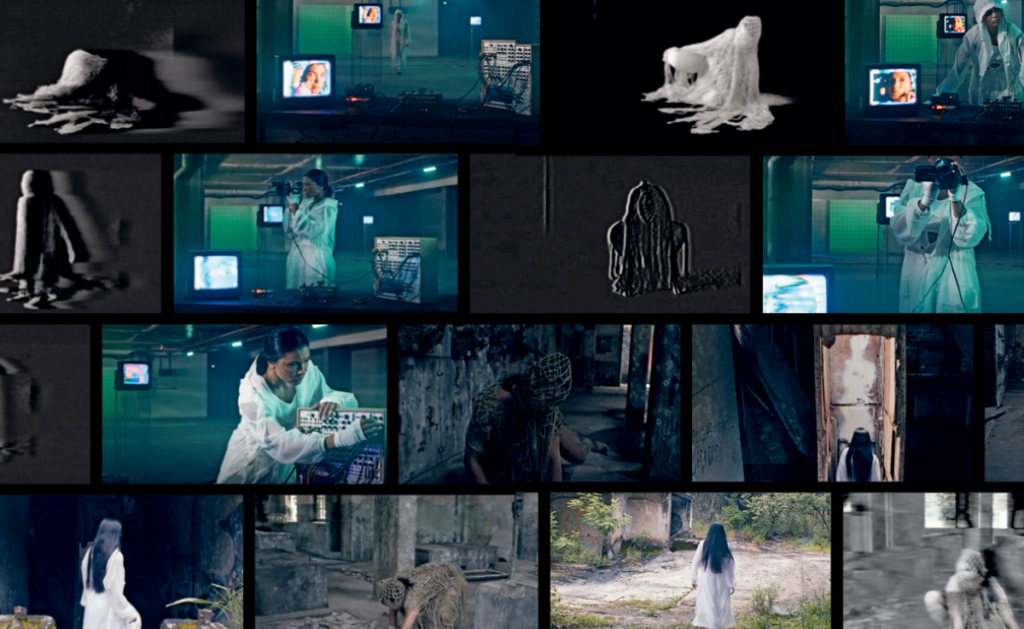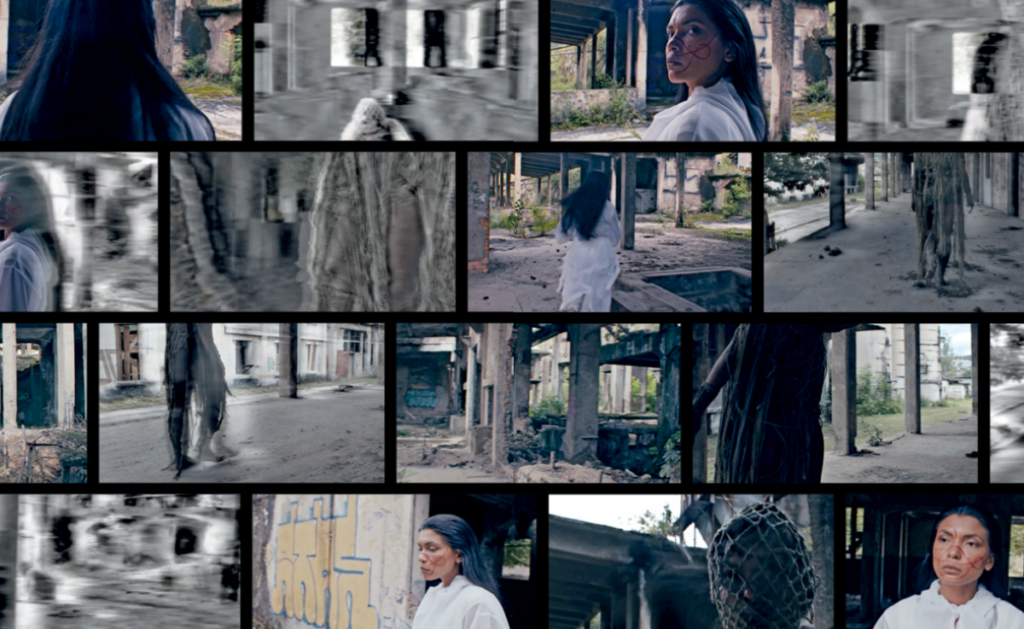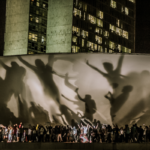Ancestral machines
Publicado em: 6 de May de 2024I am the meeting of two worlds: an ancestral world versus a “civilized” world. An encounter that clearly promotes a confrontation and ends buried by that civilization’s machines, where humans and machines merge into one body only. Where the eyes are machines of desire. We only desire what we see. We see the world from the perspective of machines. And men have had less and less the ability to broaden their primary and imaginative vision, leading them to accept or even desire a vision that is domesticated by a robotic civilization.
What is civilized? Is being civilized being considerate? Pleasant? Refined? Respectful? Polite? Polished? Sociable?
Well, do you really like being civilized? Of having been taught to read and write?
And to be enlightened, intellectualized, indoctrinated and prepared?
Is our colonized education really what we can call civilized? Could it be that we have come to an end? Does the end exist?
The end is what we become; it is a journey towards starting again.
I ask myself: what will we be able to see in 20 years’ time?
Will we still have our own visions?
One last question: what is it like to be civilized?
Zahy Tentehar in Karaiw a’e wà [The Civilized, 2022]
Fighting to exist is to carry with you all the stories and lives of a consciousness formed from the impact of relations with the other. The other, that one who is diferente – whether in culture, civilization, nationality, gender, appearance, language, belief, reality –, is essential for exchanges to happen. Seeing yourself is only possible when you can see the others. Without that, we are alone. Zahy Tentehar’s work recognizes this by invoking her perspective and her body through a continuous movement, one that is connected by her cultural identity and belonging to the Tentehar people – known as the Guajajara – and their encounters with the Western urban world. Her art presents itself as a way to bewitch and enchant. It is not bartering for mirrors, but a mirror of history, which, like an abyss, observes and is observed.
With extensive experience as a film and television actress, Tentehar was one of the protagonists in the second season of the series Cidade invisível [Invisible City, 2023], on Netflix streaming platform. There are few, however, who know of her life as a militant and multiartist. Born in the village of Colônia in the Cana Brava Indigenous Territory in the state of Maranhão, in 1989, she learned to read and write in Barra do Corda, in the same state where she first worked as a health agent, helping pregnant women. At the age of 18, she moved to Rio de Janeiro and became known as an indigenous rights activist. It was also in the Southeast of Brazil that she discovered herself as an actress and further developed her art, producing poetic, audiovisual and musical works.
In 2023, her autobiographical show Azira’i was nominated for the 34th Shell Theater Award, the most traditional award in Brazilian theater, in the categories of Dramaturgy and Actor. With a script by Tentehar herself and Duda Rios, and directed by Denise Stutz and Rios, this unprecedented and surprising solo piece focuses on the artist’s relationship with her mother, Azira’i, the first female pajé [shaman] in her community. To tell her story, Tentehar confronts the violent process of cultural transformation lived by her mother, her immediate ancestor, who bequeathed her the technologies of healing plants, hands and chants.
While defending the preservation of ancestral traditions in her works, Tentehar perfects multiples universes of senses, questioning the “civilization” that was incapable of respecting the original peoples’ other ways of life. “Our original society was thrown into a ‘civilizing’ education, almost as if we, the indigenous people, were uncivilized before that other civilization invaded this country, these lands. They tried to recivilize us, because they imposed a new civilization on us. I question this, rather than highlight it. In all my works, I seek to have an effect on those who see them, so that the viewer can also ask things and seek answers,” comments the artist in an interview specially granted for ZUM.
Memory, for Tentehar, is a place of reflection, accessed by diferente perspectives and temporalities. Having family members who are visually impaired and a child who has been diagnosed as being on the autistic spectrum (ASD) influence her perception of the world, leading her to investigate other forms of language and Other senses. Using the sensory language of her mother tongue, ze’eng eté (“good/true speech”, from Tupi-Guarani trunk), and Portuguese, the artist shows us the existence of both ancestral memories and her experiences – her coexistence with these memories. “They are two memories,” she says. “First, there is our genuine memory: ancestry, which is not only the place where we come from, but the people who lived before us, their stories. And then there is the memory crossed by this system into which we have been thrown, where we must learn to re-exist, to create a new way of life in order to adapt and survive.”
In Aiku’è zepé [I Still R-Exist, 2021], Zahy shows her restlessness as a Tentehar woman; her body is earth, nature, and nature is her body. Mud produces food, allowing this body buried by society – which imposes the erasure of its identity – to rise from the womb, from its origin, where it rests and awakens. In it, we see the representation of death and birth; rebirth is to be born or exist. The movement of this body, breathing under dry leaves, recalls the lives and stories that, like the character, may seem dry, but return into the earth, to be born again.
In a circular narrative structure, the artist’s gesture is to add, undo and restore layers of symbolic information on her face. Upon rising from the earth, she washes the mud away with the water of the river and paints designs on her body that show her identity and highlight her struggle not to be indoctrinated by the modus operandi and the western aesthetics that continually censor the cultures and ways of being of the indigenous peoples, forcing them to integrate. Next, Tentehar smears black pigment across her face – like Ailton Krenak when he protested at the Brazilian Constituent Assembly in 1987. Then she washes again and applies gloss, eyeliner, mascara and uses an eyelash curler, which makes the sound of scissors when used. She applies mud and dried leaves over her makeup, suggesting survival amid the violation of rights and the trail of chaos left by the civilized man, who restrains vital movements in an attempt to colonize free-born bodies, children of the earth that continuously embraces and generates them.
In the narrative that emerges from the earth, the chants and power of the words in ze’eng eté guide the ancestral awakening as an enchantment of the body, in its territoriality and memory of the ancestors throughout the collective journey of return to existence. Tentehar enacts that encounter with her own ancestry in transformation and the pride of her indigenous identity as a protection against the attacks of civilization, which attempts to impose commands. Instead of remaining stuck in the past, the ancestry found in everything transforms and updates. Her body is also capable of creating other lives, not just being created itself. Only at the end of the video do we realize that Tentehar is pregnant. We see female power and protagonism in her motherhood inherited from the land.
In the short film Karaiw a’e wà [The Civilized, 2022], conceived as a video installation for the exhibition Nakoada: estratégias para a arte moderna [Nakoada: Strategies for Modern Art] at the Museum of Modern Art of Rio de Janeiro (MAM-Rio), Tentehar once again reveals her experience. Speaking offscreen, she says in Portuguese: “I am the meeting of two worlds – an ancestral world versus a ‘civilized’ world. An encounter that clearly promotes a clash and ends up buried by the machines of that civilization, where humans and machines merge into one body.”
Karaiw, the word which names the work, is the non-indigenous, or civilized person, questioned for having created the imaginary of the indigenous character as barbaric and wild. The gaze on the world is built from the perspective of machines, which generate desire and inability in this “civilized” being, tied to a domesticated vision. This mirror of the essence, which is the eyes, so present in the video, observes and lets fly invisible arrows at those who watch, at every thought that the protagonist develops on the invention of this civility that robotizes everyone, not just the indigenous.
This body-machine operates in a nonhuman time. The character walks through the machinery with designs on her face, bringing once again the cultural identity of a being submerged in the machine. While civilized thinking numbs human senses and instincts, we see the sanitization of space in their use of clothing, protecting her from contamination, in the archives that, like ancestral memories, are stored in cardboard boxes; and also on the empty shelves, on which she scatters industrial waste, wearing a disposable face mask and a protective visor. The character reacts to robotization by lighting up her spirit and rescuing her ancestral memory through fire. As they emerge from her, the flames grow as soon as the character withdraws from this setting with its western technology.
The interest in technology is also evident in Máquina ancestral: Ureipy [Ancestral Machine: Ureipy, 2023], a continuation of Karaiw a’e wà. In this bold sci-fi video performance, Robotic Entity, a character who wishes to become human, travels through a ruined, abandoned space. She travels there in Search of her ancestral identity, which has been lost over time and, instead of a finished reflection on this issue, she invites the spectator to experience sensations and triggers.
The reality built by the artist operates in a manner similar to a metaverse, showing us the human versus the machine and ancestral technology as a survival tool. Resignification is a form of re-existence, it is like living inside and outside of oneself, dwelling in different places of thinking and being, without abandoning what one is. It is possible to exchange with the system, from which one does not escape, but by which one is enchanted; turning the system into an ancestral machine is using it in our favor.
Worried about the future, this memory machine gives new meaning to ancestry, no longer frozen in the past. Karaiw technology and tools such as books, theatrical shows and audiovisual productions also enable Tentehar to narrate indigenous stories in the present. “I am part of this system, I have also become a machine, but an ancestral machine, everyone who came before me is in me, they have not died, they remain alive through me,” the artist says. To rescue the millennial knowledge is, after all, to save humanity from dehumanization, from the bankruptcy of the senses and from the disruption of the connection with its cosmologies to exist today. ///
+
Scenes from the films Aiku’è zepé [I Still R-Exist, 2021], Karaiw a’e wà [The Civilized, 2022] and Máquina ancestral: Ureipy [Ancestral Machine: Ureipy, 2023].
Technical details of the films:
Aiku’è zepé [I still exist] from 2021. Artist: Zahy Tentehar; Director: Mariana Villas-Bôas; Creation and Screenplay: Zahy Tentehar and Mariana Villas Boas; Photography: Leandro Pagliaro. Editing: Raquel Couto; Colorist: Juliana Muniz; Post-production assistant: Ivan Ignacio.
Karaiw A’e Wà [The Civilized] from 2022. Artist and creator: Zahy Tentehar; Creation and direction: Zahy Tentehar, Daniel Wierman, Marcelo Hallit and Philipp Lavra; Photography direction: Marcelo Hallit; Edition and color: Breno BL; Sound design and original score: Pedro Zopelar; Text and voice: Zahy Tentehar; Production: Candombá.
Ureipy [Ancestral Machine] from 2023. Created by Zahy Tentehar; Film by Zahy Tentehar and Candombá; Creative direction: Zahy Tentehar and Candombá (Daniel Wierman, Marcelo Hallit and Philipp Lavra); Executive producer: Daniel Wierman; Visual effects and scenography: Modular Dreams (Priscilla Cesarino and Danilo Barros), Danilo Rosa and Marcelo Hallit; First assistant camera and logger: Isadora Relvas; Steadicam operator: Murillo Henrique, Breno BL; Soundtrack and sound design: Pedro Zopelar; Style photos: Philipp Lavra and Isadora Relvas; Color grading: Isabela Moura; Costume designer: Rosina Lobosco; Makeup artist: Camila Machado; Movement direction: Elaine Erhardt Rollemberg; Scenario producer: Luiz Felipe Bianchini; Catering: Sandra Godoy; Artistic producer: Elaine Erhardt Rollemberg; Gaffer: Bruno Obara; Electrical: Heitor Nogueira; Driver: Marco Diogo. Special thanks: Pedro Neves Marques, Marcela Petrus, Touts, The Paradise Rio, Ticiana Passos.
Renata Tupinambá (Niterói, RJ, 1989) is a journalist, poet, screenwriter, curator and producer. Creator of Originárias Produções, she is deputy curator at the São Paulo Museum of Art (Masp). She was co-founder of Rádio Yandê and curator of the Escuta Festival at Instituto Moreira Salles (IMS) in Rio de Janeiro (2022 and 2023).
Zahy Tentehar (Colônia, Cana Brava indigenous territory, Maranhão, 1989) is an actress, screenwriter, director and activist. She acted in series and films, such as Não devore meu coração [Don’t Devour My Heart, 2017] and Uýra: a retomada da floresta [Uýra: The Recovery of the Forest, 2022]. She directed and acted in the short film Zahy: uma fábula do Maracanã [Zahy: A Maracanã Fable, 2012] and directed Aiku’é (2017), Karaiw a’e wà (2022) and Ureipy (2023).















